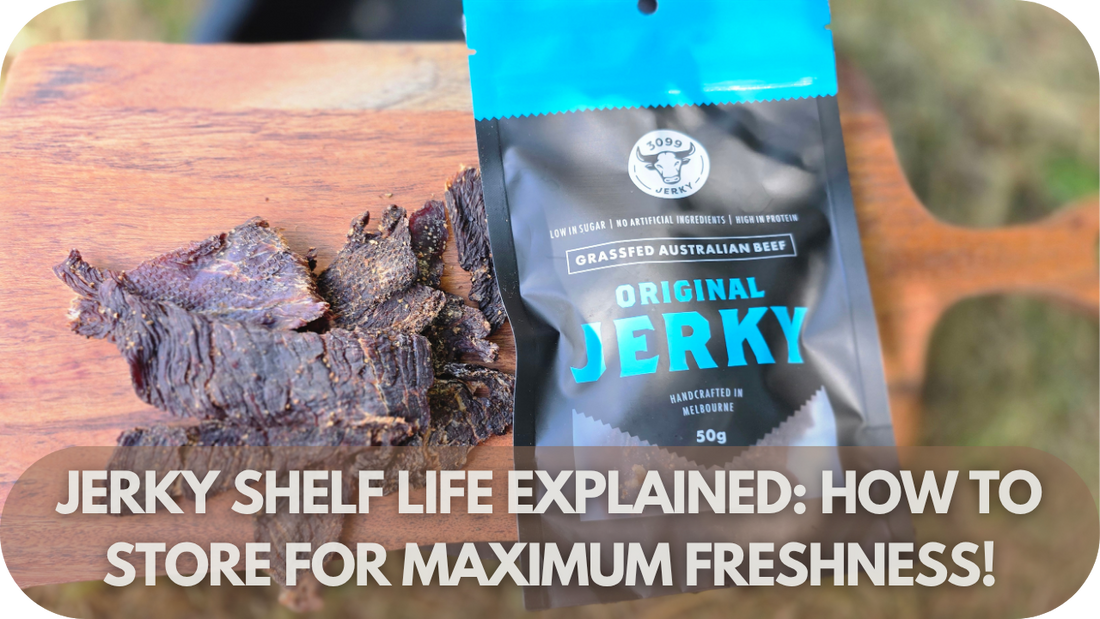
Jerky Shelf Life Explained: How to Store for Maximum Freshness!
Share
Jerky is the ultimate on-the-go snack—delicious, protein-packed, and easy to carry. But how long can it stay fresh in your pantry or backpack?
The key to enjoying every flavourful bite lies in understanding jerky’s shelf life and how to keep it at its best.
Whether you're a casual snacker or a jerky enthusiast, this guide will answer all your questions about storing your favourite snack, recognising spoilage and extending its freshness. Ready to unlock the secrets to keeping your jerky fresh longer? Let’s get started!
How Long Does Jerky Typically Last?
Commercially packaged jerky, Store-Bought Jerky, is designed to last. Unopened, it can typically stay fresh for 6–12 months, thanks to preservatives and vacuum-sealed packaging.
Once opened, however, it’s best consumed within a week or two, unless properly resealed or refrigerated.
Homemade jerky has a much shorter shelf life, usually lasting around 1–2 months if stored in an airtight container at room temperature.
Ensuring it’s fully dehydrated and stored in optimal conditions without preservatives is even more critical. Refrigerating homemade jerky can extend its freshness by another month or so, while freezing can keep it safe for up to 6 months.
Tips to Keep Your Jerky Fresh for Longer

Want your jerky to stay fresher longer? Follow these tried-and-tested tips:
1. Use Airtight Packaging
To keep your jerky fresh, always use airtight containers or vacuum-sealed bags. Whether it’s homemade or store-bought, minimising air exposure is crucial. Transfer the jerky into resealable bags or tightly lidded jars for opened store-bought packs to ensure longer freshness and better protection against spoilage.
2. Add Oxygen Absorbers
Oxygen absorbers are a great addition to your storage routine, especially for homemade jerky or when repackaging store-bought varieties. These small packets effectively remove oxygen from the packaging, slowing spoilage and preventing mould growth, which can quickly ruin your jerky.
3. Store in a Cool, Dark Place
Heat and light are enemies of jerky’s quality. Prolong its shelf life by storing it in a pantry or cupboard that is cool, dark, and dry. Avoid direct sunlight or areas with high humidity, as these factors can degrade the texture and flavour over time.
4. Refrigerate or Freeze When Necessary
Refrigeration or freezing is highly effective for longer-term storage, especially for homemade jerky. Use freezer-safe bags or containers to avoid freezer burn and ensure the jerky remains as fresh as the day it was made.
5. Label and Rotate
Always label your jerky with the date it was made or opened. This simple step allows you to monitor freshness and consume older batches first. A good rotation system prevents forgotten jerky from going to waste.
6. Vacuum-Seal Homemade Jerky Immediately
Homemade jerky tends to lose freshness quickly if exposed to air. Using a vacuum sealer immediately after drying locks in quality and prevents moisture or air from degrading your batch, ensuring it remains flavourful for longer.
7. Keep Portions Separate
To avoid exposing an entire batch to air each time you snack, divide your jerky into smaller portions before storing. This practice keeps the remaining portions sealed and protected, maintaining their freshness until you’re ready to eat them.
8. Avoid Repeated Temperature Changes
Constantly moving jerky between room temperature and refrigeration can lead to condensation, which speeds up spoilage. Store your jerky consistently in a stable environment to prevent this issue and extend its longevity.
9. Use Desiccant Packets
Desiccant packets are an excellent tool to absorb residual moisture, especially in humid climates. When combined with airtight packaging, they help maintain the optimal dryness needed to keep jerky fresh and prevent spoilage.
10. Monitor for Spoilage Regularly
Even with proper storage techniques, inspecting your jerky periodically is essential. Look for signs of mould, strange odours, or slimy textures, as these indicate spoilage. Regular checks ensure you consume only safe and high-quality jerky.
11. Opt for Vacuum-Freezer Bags for Long Storage
Invest in vacuum freezer bags if you plan to freeze jerky for an extended period. These specialised bags protect the jerky’s texture and flavour while preventing freezer burn, keeping it in peak condition for months.
Key Factors That Affect Jerky’s Shelf Life

Jerky’s longevity hinges on several key factors, ranging from its preparation to how it’s stored. Here’s what you need to know:
- Moisture Content: proper dehydration removes most water, preventing bacteria and mould growth; undried pockets of moisture can lead to spoilage; aim for a dry, chewy texture with no wet or soft spots.
- Preservatives and Additives: store-bought jerky contains preservatives like nitrates, nitrites, and salt to slow spoilage; homemade jerky without preservatives is more prone to bacteria unless refrigerated or frozen.
- Packaging: vacuum-sealed bags and airtight containers limit oxygen exposure, preventing oxidation and spoilage; resealable pouches with oxygen absorbers provide added protection; poorly sealed or damaged packaging allows air and moisture, accelerating deterioration.
- Storage Conditions: unopened jerky should be stored in a cool, dark pantry; homemade or opened jerky should be refrigerated or frozen to prolong freshness; heat, humidity, and light exposure degrade quality and increase spoilage risk.
- Quality of Ingredients: lean cuts of meat with minimal fat reduce the risk of rancidity; trimming excess fat during preparation extends the jerky’s shelf life.
- Handling Practices: clean hands, equipment, and surfaces during preparation to prevent bacterial contamination; cross-contamination with raw meat and improper temperature control during drying compromise safety.
- Marination and Seasoning: salt-heavy marinades enhance flavour and preservation; overly sweet or sticky coatings attract moisture, reducing shelf life unless consumed quickly.
Common Mistakes to Avoid

Even seasoned jerky enthusiasts can make mistakes that reduce shelf life. Avoid these common pitfalls:
- Leaving Jerky Exposed to Air: Forgetting to reseal packaging after opening is a fast track to stale, spoiled jerky. Always seal it tightly after use.
- Storing in Warm, Humid Environments: Keeping jerky in your car, kitchen counter, or other warm areas can lead to quicker spoilage. Stick to cool, dry storage spaces.
- Assuming Expiry Dates Are Irrelevant: While jerky often lasts beyond its best-before date, always check for signs of spoilage before eating older packs. If it smells sour or has visible mould, it’s time to toss it.
- Overlooking Moisture During Dehydration: Failing to dehydrate properly for homemade jerky is one of the most common mistakes. Any remaining moisture can drastically shorten shelf life.
Conclusion
Ready to enjoy fresh, flavourful jerky for longer? By understanding the key factors that impact its shelf life and following these simple storage tips, you can savour every bite without worrying about spoilage. Whether making your jerky or storing your favourite store-bought brands, a little care goes a long way.
Don’t let your jerky go to waste—start using these tips today and keep your snacks as delicious as the day they were made! Share this article to help others preserve their jerky too!
